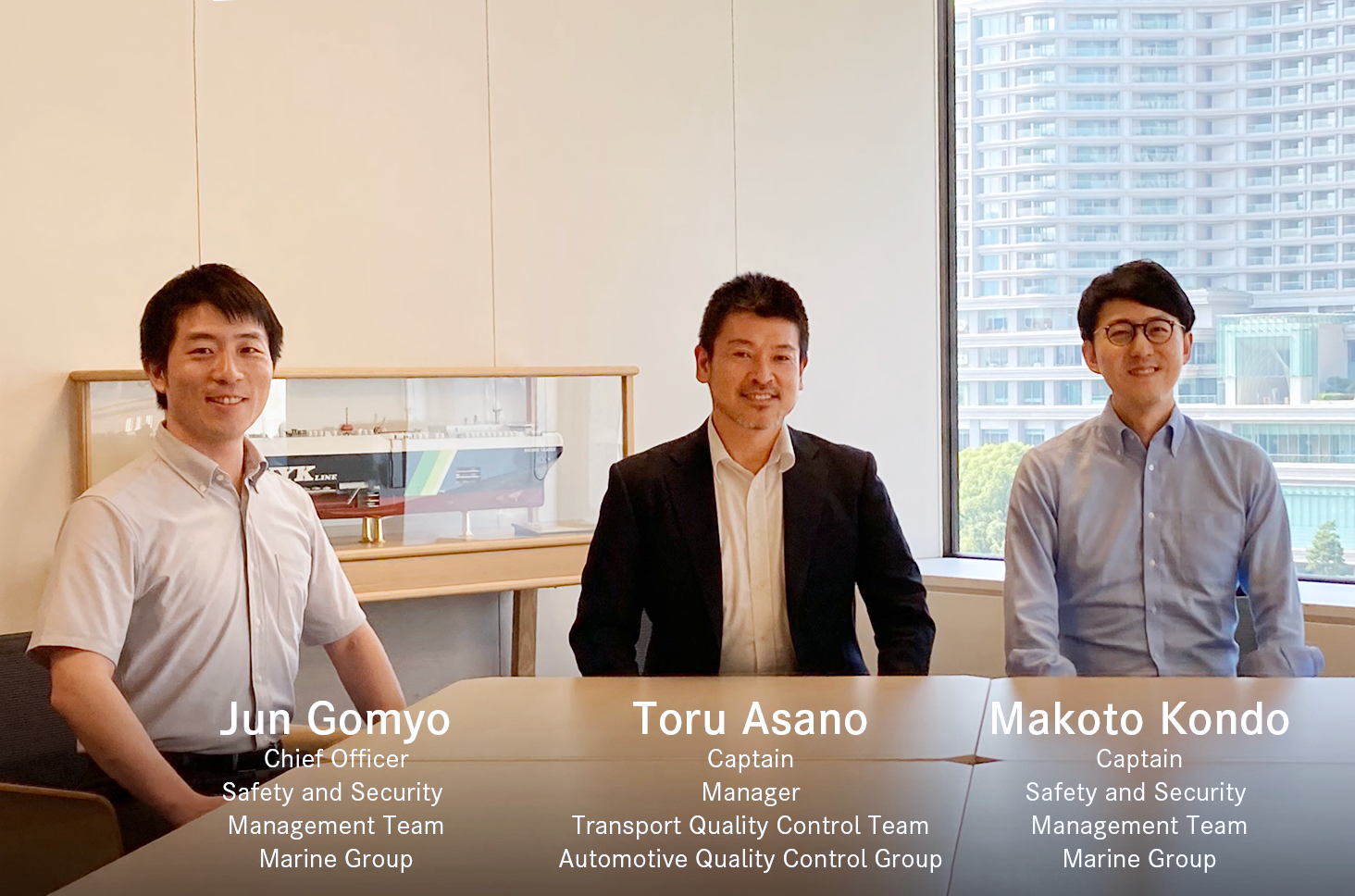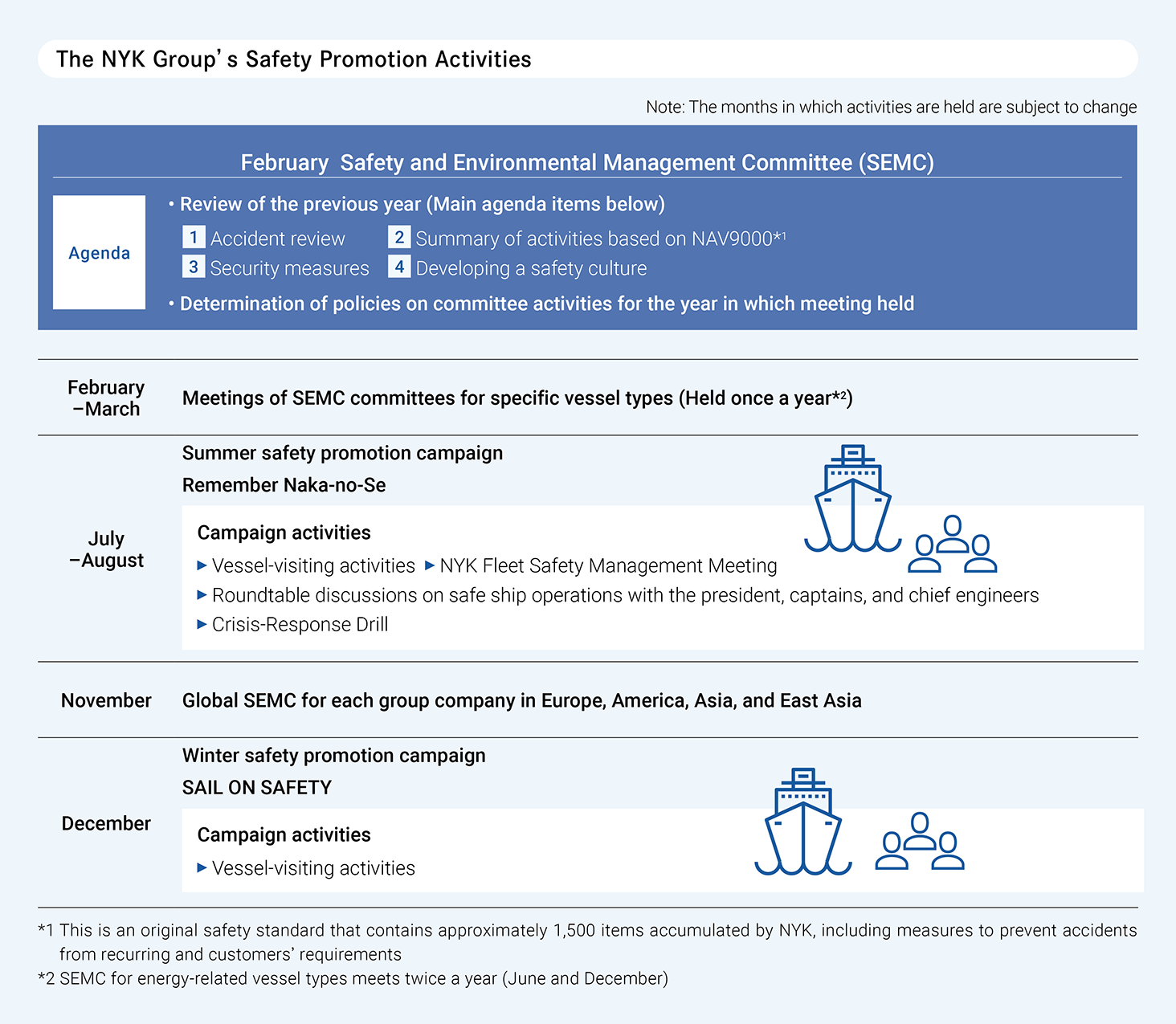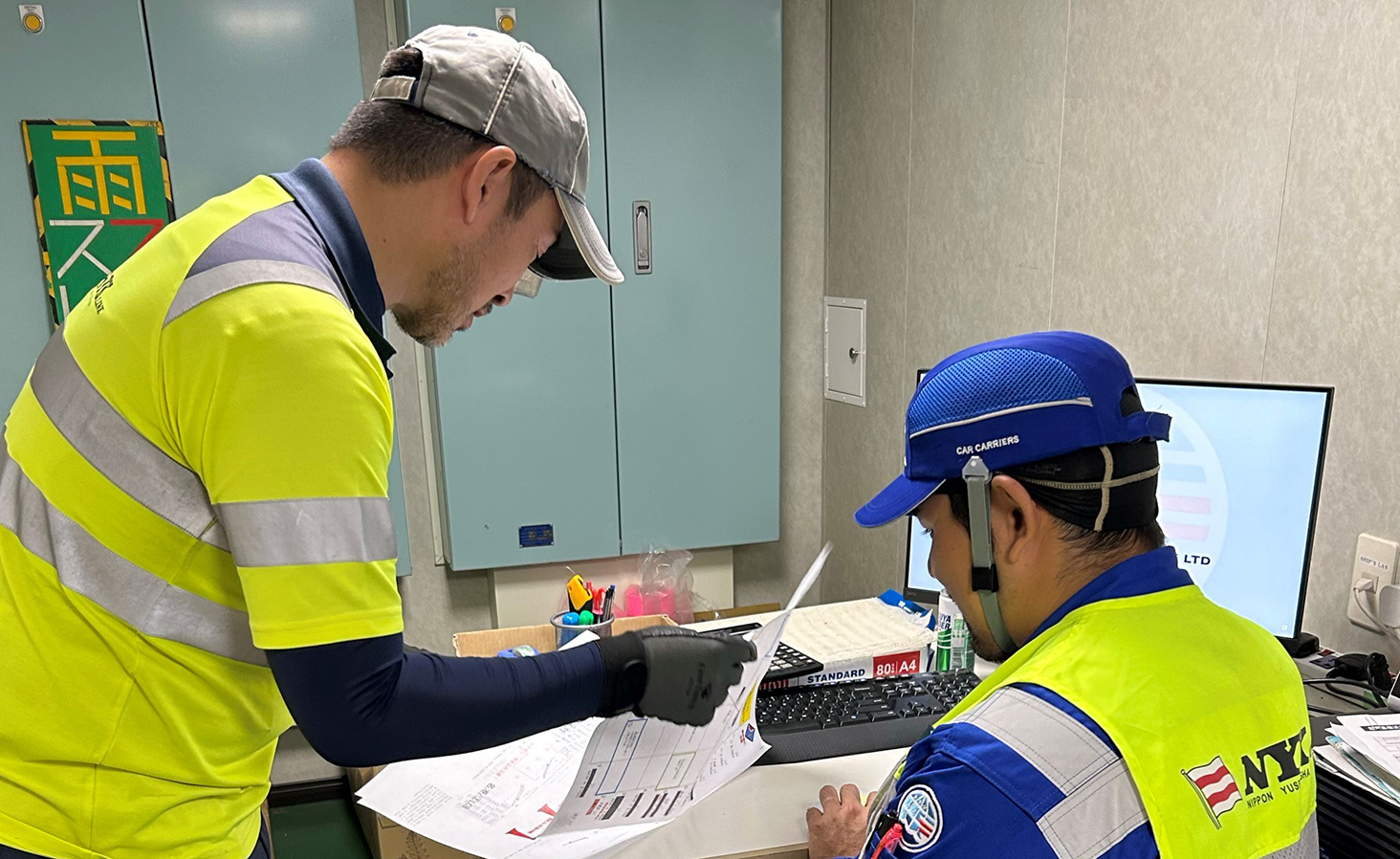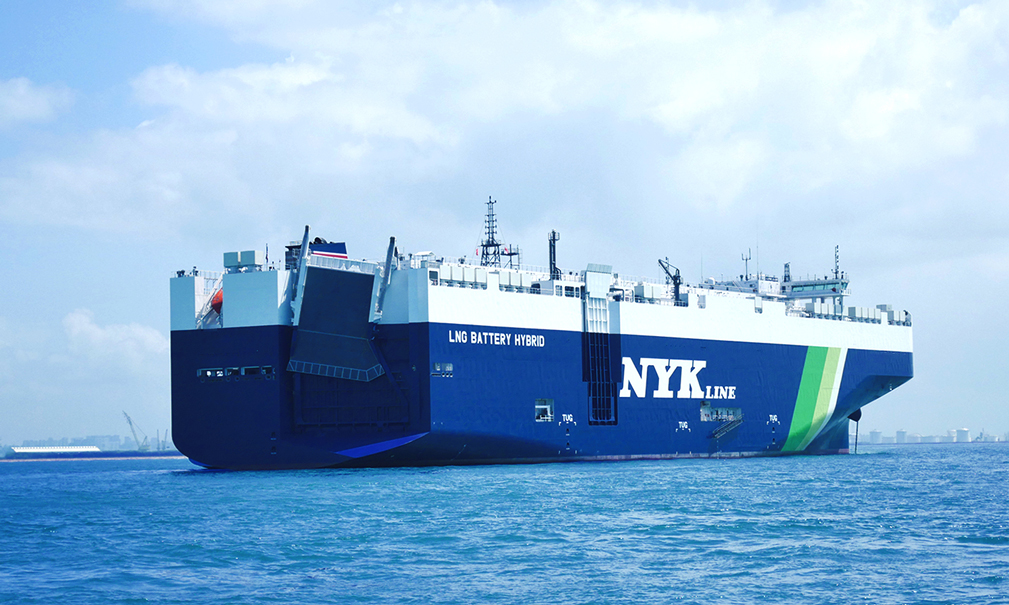Continuing to Pursue All Aspects of Safe Ship Operations
Reflecting the Group’s belief that safety underpins trust and that trust underpins business, the NYK Group has unstintingly devoted time and effort to ensuring safe ship operations. In the Group’s businesses, which are centered on the transportation of goods, a serious accident could threaten human life, damage cargo, and have an immeasurable impact on the environment.
The NYK Group continues to pursue all aspects of safe ship operations. In 2001, we established the Safety and Environmental Management Committee, chaired by the president. In Japan and overseas, our offshore personnel and onshore office personnel, as well as our technical personnel, make concerted efforts to advance activities related to safety and the environment and to establish and develop systems for the advancement of safety. In addition, two safety promotion campaigns are conducted every year, in summer and in winter, to make safety promotion efforts an integral part of the NYK Group’s corporate culture and to further promote safety activities.

Passing on the Lessons of an Accident
At 10:04 a.m. on July 2, 1997, the crude oil tanker Diamond Grace, operated by NYK, came into contact with the Naka-no-Se shoal in Tokyo Bay. This caused a crack in the ship’s bottom from which 1,550 kiloliters of crude oil spilled into the sea. This accident reaffirmed to NYK that ensuring safe ship operations is the Company’s most important social responsibility. To pass on the lessons learned from the accident, we have conducted the Remember Naka-no-Se safety promotion campaign every summer for more than 25 years.
In this campaign, senior management, officers, and employees visit vessels. In addition, NYK fleet safety management meetings in Japan and overseas and roundtable discussions on safe ship operations with the president, captains, chief engineers, and seafarers are held to provide opportunities for stakeholders in offshore and onshore operations to exchange opinions and deepen mutual understanding. In 2023, a total of 565 people visited 263 vessels. Vessel-visiting activities have until now focused on Japan. To raise safety awareness even further, in 2024 we plan to expand these activities globally. The number of vessel visitors is also expected to increase.
Makoto Kondo, a member of the Marine Group’s Safety and Security Management Team, says that it is rare globally for shipping companies to go as far as enacting measures for the safe ship operations of all of their group companies.
“If there is a serious accident, it is reported to the president at the Management Meeting, after which major concerns are shared with the Safety and Environmental Management Committee. The concerns are then shared with the seafarers of all vessels in operation in the following year’s campaign. In some cases, said concerns are incorporated into the activity goals. The president always emphasizes that safety is the top priority of Group management. I feel the system we have in place effectively promotes safety among all Group companies.”

The campaign focuses on timely themes. In fiscal 2024, three themes were covered, including maritime accidents due to abnormal weather conditions. These accidents occurred in fiscal 2024. Jun Gomyo, a member of the Marine Group’s Safety and Security Management Team, explains one aim of fiscal 2024’s campaign.
“Recent abnormal weather conditions have led to stronger-than-expected wind gusts. These gusts have caused accidents despite the best efforts of both onshore personnel and seafarers to deal with them. By sharing these examples, we want to alert people to hazards, including the possibility that, in the future, unexpected situations could arise again due to abnormal weather conditions.”
Responding to Unexpected Situations through Training and Information Sharing
In 2024, a pure car and truck carrier operated by NYK was hit by gusting wind and came into contact with a vessel moored on the opposite pier. Unlike the anchor-dragging accidents that generally occur, the accident occurred while the vessel was on the berth. Pure car and truck carriers are box-shaped ships rising about 40 meters above the sea surface and with total lengths of approximately 200 meters. They are greatly affected by the wind. However, Toru Asano, who is manager of the Automotive Quality Control Group’s Transport Quality Control Team and was involved in the onshore response, recalls the event and says he had never heard of an accident of this kind, in which a vessel was moved away from the pier.
Asano describes how frontline personnel responded to the unprecedented situation.
“The port where the accident took place is prone to strong winds. At the time of the accident, strong winds were forecast. So, crew members were on alert. Vessel’s Master had seen the forecast and anticipated gusty winds. So, he halted cargo-handling operations in advance and arranged for a pilot and tugboats to be on hand. Right when the vessel began drifting, an on-site decision was made to call four tugboats to try to push the vessel back. However, even this measure did not work, and stronger-than-expected gusts blew the vessel back out. As a result, the vessel drifted to the opposite pier.”
One consolation is that no one was injured, and the cars being transported were not damaged. Without the advance preparation and immediate decisions of on-site crew-members, casualties and cargo damage could have occurred. The fact that the damage was kept to a minimum is in virtue of the preparedness and judgment of them.
In accordance with international rules, vessels engaged in maritime shipping conduct drills throughout the year for fire, flooding, collision, and stormy weather scenarios. The NYK Group strengthens safety promotion campaigns by immediately distributing the latest information. For example, Casualty Report carries flash reports about accidents, Safety Bulletin explains strategies for preventing accidents and problems, Marine Engineering Information specializes in technical matters, and Security Information focuses on security issues.
Gomyo offers analysis.
“I believe that even in an unexpected situation like this, we were able to respond quickly by applying and developing the fundamentals of safety measures.”
Knowing Frontline Operations Leads to Future Safety
For the vessel-visiting activities of safety promotion campaigns, a safety team undertakes coordination efforts so that vessels are visited by as many personnel as possible. These are mainly onshore personnel who are engaged in work or belong to sales departments related to ship operations. Kondo explains the significance of vessel-visiting activities.
“When working onshore, personnel tend to perceive vessel accidents as on-screen events. However, having personnel actually visit vessels gives them a chance to experience firsthand what is happening in frontline operations. I feel that vessel-visiting activities are important for instilling an awareness of safety among Group employees.”
Gomyo agrees.
“As a business, profit is important, but safe ship operations are our first priority. For seafarers, vessel-visiting activities are an opportunity to remind them that safety must be the top priority in all of their decisions and actions. For onshore personnel, face-to-face communication with seafarers facilitates learning about the actual safety issues encountered by frontline personnel as well as their safety needs.”
Many personnel have commented that face-to-face communication during vessel visits has allowed both sides to express their opinions more readily and led to smoother communication between onshore and offshore operations. Asano, Kondo, and Gomyo all agree that making frontline operations feel closer and encouraging smooth communication are very important for safe ship operations. They also say that seafarers’ experience of onshore work gives a firsthand understanding of roles in both offshore and onshore works.
Asano explains the benefits of understanding offshore work.
“Working at sea literally involves doing everything you can to deal with events at sea. At such times, obscure instructions from the onshore operations can cause unnecessary confusion. Through onshore work I understand role of them and can consider about what can be done when an accident occurs referring my experiences form offshore work.“

Viewing Safety as a Source of Competitiveness
The Remember Naka-no-Se summer safety promotion campaign was begun to prevent the Diamond Grace grounding accident from fading from memory. The campaign not only passes on the story of maritime accidents in the NYK Group but is also an important activity for instilling safety awareness in the Company, Group companies, and partner companies. Safety activities have made frontline operations seem closer and facilitated work. Therefore, safety can be seen as a source of the NYK Group’s competitiveness. Safety activities never end. As long as it has a culture of earnest commitment to safety, the NYK Group will continue to be needed and respected by society.
(Interview July 5, 2024)





